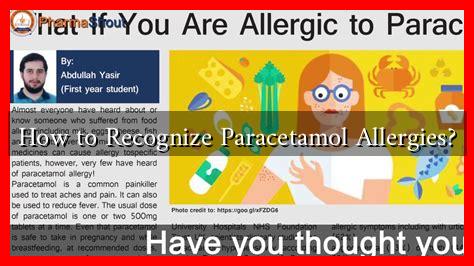-
Table of Contents
How to Recognize Paracetamol Allergies?
Paracetamol, also known as acetaminophen, is one of the most commonly used over-the-counter medications for pain relief and fever reduction. While it is generally considered safe for most people, some individuals may experience allergic reactions to this medication. Recognizing the signs of a paracetamol allergy is crucial for ensuring safety and effective treatment. This article will explore how to identify paracetamol allergies, the symptoms to watch for, and what steps to take if you suspect an allergy.
Understanding Paracetamol Allergies
Allergic reactions to paracetamol are relatively rare but can occur. An allergy is an immune response to a substance that the body mistakenly identifies as harmful. In the case of paracetamol, the body may react to the drug or its metabolites, leading to various symptoms. It is essential to differentiate between an allergy and other adverse reactions, such as side effects or drug interactions.
Common Symptoms of Paracetamol Allergies
Recognizing the symptoms of a paracetamol allergy can be challenging, as they may vary from person to person. Common symptoms include:
- Skin Reactions: Hives, rashes, or itching can occur shortly after taking paracetamol.
- Respiratory Issues: Difficulty breathing, wheezing, or a tight feeling in the chest may indicate a severe allergic reaction.
- Gastrointestinal Symptoms: Nausea, vomiting, or abdominal pain can also be signs of an allergic response.
- Anaphylaxis: In rare cases, paracetamol can trigger a life-threatening reaction known as anaphylaxis, characterized by swelling of the throat, rapid pulse, and loss of consciousness.
Case Studies and Statistics
While paracetamol allergies are uncommon, studies have shown that they do occur. According to a study published in the Journal of Allergy and Clinical Immunology, approximately 1 in 10,000 individuals may experience an allergic reaction to paracetamol. In one case study, a 30-year-old woman developed urticaria and angioedema after taking paracetamol for a headache. This case highlights the importance of recognizing symptoms early and seeking medical attention.
How to Diagnose a Paracetamol Allergy
If you suspect that you or someone you know may have a paracetamol allergy, it is essential to consult a healthcare professional. Diagnosis typically involves:
- Medical History: A thorough review of the patient’s medical history and any previous reactions to medications.
- Skin Tests: In some cases, skin prick tests may be conducted to assess the body’s reaction to paracetamol.
- Oral Challenge: Under medical supervision, a healthcare provider may administer small doses of paracetamol to observe for any allergic reactions.
What to Do If You Suspect an Allergy
If you experience symptoms after taking paracetamol, it is crucial to take the following steps:
- Stop Taking Paracetamol: Discontinue use immediately if you suspect an allergy.
- Seek Medical Attention: Contact a healthcare provider for advice and potential treatment options.
- Inform Healthcare Providers: Make sure to inform all healthcare providers about your allergy to prevent future exposure.
- Consider Alternatives: Discuss alternative pain relief options with your doctor, such as ibuprofen or aspirin, if appropriate.
Conclusion
Recognizing paracetamol allergies is essential for ensuring safety and effective treatment. While allergic reactions are rare, being aware of the symptoms and taking appropriate action can prevent serious health complications. If you suspect an allergy, consult a healthcare professional for diagnosis and management. Always prioritize your health and well-being by staying informed about the medications you take.
For more information on drug allergies and their management, you can visit the Australian Society of Clinical Immunology and Allergy.



